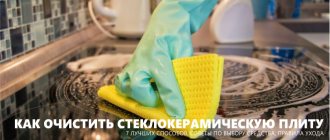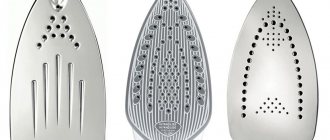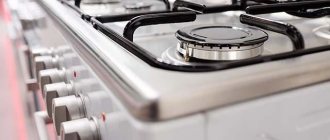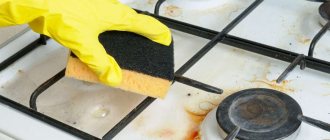To understand how to clean a stove with a glass-ceramic surface, you should know some of the nuances of the material itself from which this coating is made.
- Features of electric glass-ceramic hobs
- Caring for a ceramic hob - what materials and tools should be used
- How to clean a glass-ceramic panel: industrial products and household chemicals
- Rating of the most popular products on the market
- Comparison table of the best cleaning products for glass-ceramic panels
- How to clean a ceramic stove using scrap materials
- What absolutely should not be used when cleaning glass ceramics
Features of electric glass-ceramic hobs
Glass ceramics are based on the use of ceran material, which is characterized by increased impact resistance and low thermal expansion.
For your information!
If water is poured onto the surface of a hot stove, cracks will not form due to temperature changes. The average service life at home, which is guaranteed by the manufacturer, is 15 years.
Typically, such stove models are equipped with halogen burners or a High Light system, in which heating is provided by means of a heating tape made of a special alloy located under the ceramics, wrapped in symmetrical rings.
Externally, glass ceramics is a perfectly smooth surface that has a pleasant appearance. Cooking food for a long time leads to the appearance of soot, grease stains and other difficult-to-remove contaminants. Therefore, every housewife will find useful information on how, and most importantly, how to clean a ceramic slab so that it retains its original appearance throughout its entire service life.
Caring for a ceramic hob - what materials and tools should be used
The most important rule to know when looking for an answer to the question of how to clean a glass-ceramic stove is to avoid abrasive materials that can cause scratches on the surface. It is also not recommended to use strong household chemicals for cleaning, which may contain aggressive reagents and alkalis that lead to damage to the ceramics and the appearance of stains on it.
The procedure for cleaning the glass-ceramic surface itself can be presented in the form of two main stages:
- removal of old stains and heavy dirt by mechanical means;
- final cleansing using liquid products and soft sponges.
Glass ceramic hob scraper
How can you clean a glass-ceramic stove if burnt stains of fat, sugar or pieces of food appear? It will be difficult to do this with a simple rag. A special device comes to the rescue - a scraper. Structurally, this accessory consists of:
- a handle holder, which can be plastic or metal;
- blade, made in the form of a movable element or fixed;
- a screw used to replace the blade or fix it in position.
Important!
Scrapers made of plastic and having a fixed blade have a shorter service life than steel scrapers with moving elements.
It is advisable to purchase a scraper to clean a glass-ceramic hob in the following cases:
- there is a large amount of dried contaminants on the surface;
- it is necessary to quickly remove burnt food residues while the stove is still hot;
- Preventing scratches on the panel surface.
The procedure for using a scraper for cleaning glass ceramics is carried out according to the following scheme:
- You must first use a soft flannel cloth soaked in a special cleaner for glass-ceramic stoves to wipe the contaminated area.
- Wait some time until completely dry.
- Place the scraper at an angle of 30° to the surface and move back and forth.
- Upon completion, the stove is wiped again with a clean cloth.
For your information!
If you spend a lot of time or have to exert significant effort when cleaning with a scraper, then most likely the blades are dull and need to be replaced.
The cost of a scraper for cleaning glass ceramics will depend on the material and manufacturer. Plastic tools sell for no more than 100 rubles, but for high-quality metal accessories you will have to pay 300-500 rubles. Replacement blades cost about the same.
Napkins and sponges
The next important tool you can use to clean a ceramic hob is rags and sponges. One of the latest innovations is a special development that combines not only the cleaning accessory itself, but also the cleaning agent itself. We are talking about a melamine sponge.
The basis of this tool is melamine resin, which, after swelling, acquires a spongy state. Outwardly, such a sponge resembles a light block, no different from the usual piece of foam rubber that most housewives use. But appearances are deceiving. If we draw analogies in terms of cleaning power, we can say that the hardness of the material is similar to the strength of glass, and its abrasive properties are akin to sandpaper. The secret of efficiency lies in the special production technology of melamine foam.
Using a sponge is simple - just moisten it with water and clean it. At the same time, it is capable of removing even difficult stains. A prerequisite for this cleaning method is the subsequent removal of residual cleaning agent with water and wiping the panel dry with a towel.
Important!
One tip for using sponges is to avoid using dishwashing utensils. This is explained by the fact that when the cleaning agent reacts with residual grease on the sponge, a thin film is created on the working surface, which burns out when heated, and the panel loses its appearance.
Rating of the most popular products on the market
It should be noted that, despite the abundance of household chemicals intended for work in the kitchen, there are not so many products whose purpose is to care for glass ceramics. All products, regardless of the manufacturer, have one thing in common - the presence of silicone or silicone oil. Chemical – oligoorganosilicane. The main purpose of the component is to create the thinnest protective film, which simplifies the removal of grease stains and prevents further contamination.
The three best products, according to customer reviews, are represented by the following products.
Selena-extra
A cleaning composition that, according to the manufacturer, can cope with any dirt and does not irritate the skin of the hands, although it is recommended to work with gloves. Shake thoroughly before application. The product helps remove even old grease stains without much physical effort. A small amount of silicone in the composition does not provide sufficient polishing of the surface of the plate. Cost: 50 rubles.
Price: ₽ 46
Domax
A product that is ideal for daily cleaning. It removes stains and simple stains very well, but cannot cope with already dried stains, so the use of additional products is required. This product contains much more silicone oil, so its effect is more like furniture polish. Cost: 300 rubles.
Price: ₽ 275
Dr. Beckman
A composition that helps to quickly deal with fresh stains. If you need to remove dried stains, you must first apply the product and leave for a few minutes. Does not contain strong chemicals, so hand skin irritation is minimal. With regular use, it creates a film on the surface, which prevents the rapid formation of contamination. Cost: 350 rubles.
Price: ₽ 365
What and how to clean at home?
If you are the happy owner of a glass-ceramic stove, and do not yet know how to care for it, this article is just for you, because now you will learn about effective methods for cleaning such a delicate surface.
A glass ceramic hob needs to be cleaned regularly as plain water can leave nasty stains and marks on the hob. Try to ensure that the diameter of the pans exactly matches the diameter of the burners. Grease splashes during frying immediately settle on the hob, so, whatever one may say, you will have to clean the stove every day
.
Comparison table of the best cleaning products for glass-ceramic panels
| Name | Main characteristics | Price |
| Selena-extra | It is able to cope with any dirt, does not irritate the skin of the hands, and helps remove even old grease stains. | ₽ 46 |
| Domax | Removes stains and simple stains, but cannot cope with already dried stains; it contains a large amount of silicone oil. | ₽ 275 |
| Dr. Beckman | Helps quickly deal with fresh stains and does not contain strong chemicals, so hand skin irritation is minimal. | ₽ 365 |
Additionally, you can find recommendations on how to wash a glass-ceramic stove, besides specially developed products. This includes glass and mirror cleaning liquids. They are used to improve the appearance and add shine to the panel.
How to clean a glass-ceramic hob with special products
The procedure for cleaning the glass-ceramic panel requires disconnecting the device from the power supply. This is important for two reasons:
- preventing short circuits due to liquid ingress;
- Reducing the risk of electric shock during cleaning.
The next step is to wait for it to cool completely. This warning is not only about preventing burns.
The general algorithm for cleaning glass ceramics is described by the following diagram:
- It is recommended to first moisten the surface with a soft cloth or sponge;
- to areas of more severe contamination or grease stains, it is necessary to apply a cleaning agent and wait for a certain time;
- Use a soft sponge to thoroughly wipe the surface of the stove;
- in areas of particularly heavy contamination, the cleaning procedure will need to be repeated;
- After this, the remaining cleaning agent should be completely removed from the frying panel with a damp cloth and finally wiped dry with a towel.
To clean stubborn stains from milk, sugar or other burnt foods, you need to apply a cleaning agent to the surface of the stain, leave it for about half an hour, and then use a scraper.
Preparation and selection of detergents
Electric stoves, which are most often used in everyday life, are divided into open and closed. Open ones are equipped with a spiral or disk heating element located outside, closed ones are equipped with induction, halogen, tape, etc., hidden under the hob.
Despite the significant differences between the devices, the following rules must be observed before cleaning any of them:
- Set the rotary switches to the zero position.
- Disconnect the stove from the power source.
- Wait until the burners and hob are cold.
- If the burners are wet, they must be wiped dry before processing.
Now you can decide on a detergent . There are also a number of nuances to consider here:
- You should avoid using abrasive equipment that can scratch parts of the slab. It is best to use double-sided foam sponges, lint-free rags, special scrapers for washing and soft cloths for drying and polishing.
- It is most convenient to treat hard-to-reach places using bottles with a spray bottle, cotton swabs and a toothbrush.
- If you plan to clean the electric stove with chemical compounds, it is better to avoid powders. Crystals of powdery substances will leave microscopic scratches on the parts of the device, which over time will affect its appearance.
- You need to be extremely careful when working with liquid cleaners, as they can flood the heating element and damage it.
- Wash the stove from contamination using the most rationally gentle folk remedies or ready-made gel, cream, paste.
How to clean a ceramic stove using scrap materials
If it is not possible to use chemical cleaning products, folk recipes come to the rescue. There are many objects around a person that can be used as a cleaning product.
How to clean a ceramic hob using vegetable oils
One of the proven ways to deal with severe and old stains on the surface of glass ceramics is to use regular vegetable oil.
To get rid of grease or carbon stains, you need to soak a soft cloth or sponge with a small amount of oil and place on the stain for half an hour. After this, the dried fat will become pliable and can be removed using conventional methods.
How to clean a glass-ceramic stove with baking soda and lemon juice
The next reliable recipe for cleaning glass-ceramic surfaces is to use a mixture of baking soda and lemon juice.
For your information!
There is no need to worry that using powdered soda will compromise the integrity of the ceramic. This is a very soft abrasive that is not capable of damaging hard surfaces.
To prepare the cleaning product, you need to dilute a small amount of baking soda with water to form a paste, which is applied to burnt stains of fat or food. The applied composition is left on the stained surface for 10-15 minutes, after which the area is wiped with a soft sponge. If the stains are so strong that regular baking soda cannot cope, then you can add a few drops of lemon juice to the soda patch. A violent reaction will lead to the fact that the remaining fat is quickly destroyed. This is followed by the usual procedure of wiping with a sponge or rag.
Vinegar as a cleaning agent
What else can you use to clean a glass-ceramic panel? Regular table vinegar. The positive side of this method is not only the ability to achieve a clean ceramic surface, but also disinfection of the hob and other kitchen utensils. To prepare a cleaning solution, you need to pour equal proportions of warm water and 9% vinegar into a spray bottle, mix it all thoroughly and spray it onto the surface of the dirt. After just a few minutes, the stove is wiped with a clean paper towel.
Ammonia - replacement for glass cleaner
Another way to ensure the cleanliness of a glass-ceramic panel is to use ammonia. You need to add 50 ml of it to a glass of warm water and spray the resulting solution onto the surface of the stove. Next, you need to wait for 10 minutes, then remove any remaining dirt with a dry towel or napkin. In addition to removing stubborn stains, this method allows you to achieve a crystal shine on ceramics.
What absolutely should not be used when cleaning glass ceramics
There are a number of tools and products that are strictly contraindicated for glass-ceramic surfaces. This includes:
- kitchen knives or other sharp metal objects;
- hard sponges, brushes or washcloths;
- powdered abrasive agents;
- aerosols intended for ovens;
- Dishwashing detergents that leave difficult to remove stains on the surface.
Following simple cleaning rules and using recommended tools and cleaning products will preserve the ceramic panel throughout its entire service life, which, remember, is 15 years. Once again, you can familiarize yourself with the rules for caring for glass ceramics from the presented video.
How to remove with special preparations?
There are compositions on sale that are designed to remove carbon deposits from various products. You can purchase care products for:
- behind the slabs,
- dishes,
- grill and more.
The main thing is to use them for their intended purpose. Top 3 compositions for combating carbon deposits:
Forte Plus Sano
Active foam is easy to apply using a sprayer . The composition acts quickly and effectively, thanks to the high concentration of cleaning substances. The product is suitable for caring for:
- microwave oven,
- kitchen stoves,
- grills,
- ovens.
Price – 600 rubles. Read reviews here and here.
Stop-burn + Anti-nagar
The composition for cleaning stoves and grills can be used to remove smoke from metal and enamel surfaces. It effectively copes even with old stains . Price – 200 rubles.
Kenolux Grill CID Lines
Concentrated liquid to combat carbon deposits and old fat. The composition is suitable for processing stoves, ovens and grills. Price – 800 rubles.
You need to choose a product that is marked “from carbon deposits” . Universal broad-spectrum formulations may be ineffective.











